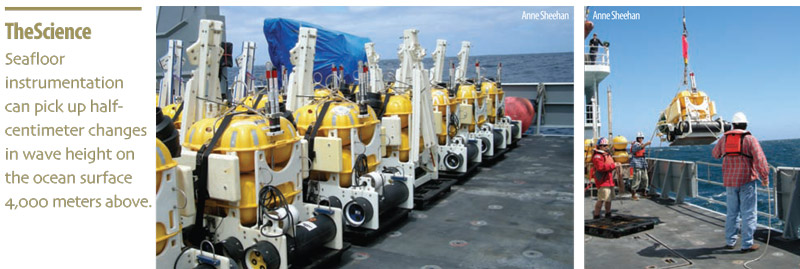Eavesdropping on Tsunamis
Underwater instruments assist early-warning systems

By Jane Palmer
When Anne Sheehan retrieved her group's ocean bottom seismometers (OBSs) offshore of New Zealand in 2010, it wasn't only the recorded heaves and shudders of five major earthquakes that caught her attention. It was the relatively faint ripples chronicled on the accompanying seafloor pressure gauges—which measured half-centimeter changes in wave height on the ocean surface nearly 4,000 meters above—that astounded her.
The seafloor pressure gauges had picked up a tsunami in the seas above.
Like land-based seismometers, OBSs record ground motions, including the seismic waves of earthquakes, but seafloor pressure gauges capture seismic waves and also changes in the height of the water column above. "It was a big surprise," said CIRES Fellow Anne Sheehan and Associate Director of CIRES Solid Earth Sciences Division. "We are used to getting seismic waves but the water waves? To be able to see those as they go over the sensor was pretty amazing."
The potential use of these deft instruments struck Sheehan immediately. "When I saw the results, I thought, 'Wow, we should see if we can use these to inform tsunami estimates and warning systems,'" she said.
CIRES at sea
Sheehan, CIRES Fellow Peter Molnar and their colleagues at Woods Hole Oceanographic Institution and the Massachusetts Institute of Technology had originally launched the OBSs and differential pressure gauges (DPGs)—instruments designed to measure the differences in pressure—into the ocean in 2009 with the goal of learning more about the structure under New Zealand's Alpine Fault. "It was a 'drop and pray' approach," Sheehan said. "Sometimes the instruments don't come back."
The scientists had surveyed the sea floor with sonar before choosing the "sinking sites," Sheehan said. No steep slopes the instruments might tumble down, no submarine canyons, nor regions of heavy currents where the ocean noises might interfere with the signals. "We try to put them in places where there is some sediment, some goopy stuff or some mud so they will sink into it," she said.
The scientists' precautions paid off. One year later, the team successfully collected 29 of the 30 instruments. It was then they saw not just the roars of the seismic data, but the relative whispers of the tsunami activity. "To get that as a by-product of a seismic experiment was very interesting," Sheehan said. "I had never seen that done with ocean-bottom seismometers before."
Predicting the unpredictable
While earthquakes still cannot be predicted with certainty, in the last decade scientists have made strides in issuing warnings, watches and evacuations for the tsunamis that accompany them. NOAA launched its DART (Deep-ocean Assessment and Reporting of Tsunamis) recording buoys in 2008 to help provide real-time tsunami detection as the waves travel across the deep-ocean. These instruments also use seafloor pressure gauges, but they are sparsely spaced in the deep ocean, Sheehan said, limiting their forecasting power. Following the 2010 Chilean earthquake, for example, scientists overestimated the tsunami threat to Hawaii and the western Pacific because it took three hours for the tsunami to hit the closest DART buoy, delaying the time the scientists could use real information to refine their models.
The data from seafloor pressure gauges collected as a byproduct of OBS experiments offer an exciting opportunity to measure tsunami waves, Sheehan said. The information gathered can help scientists reconstruct the entire process of tsunami propagation and transformation from the open ocean through the continental shelf, and also help them refine their forecasting models. In addition, the project has sparked and strengthened international collaborations with other research institutes, she said. "People are pretty much lining up to work with the data."


